
How to Find an X-Intercept
4 min read•november 23, 2021
hingryjulia
hingryjulia
Finding X-Intercepts for Function
The x-intercept of a function is the x-value for which the graph intersects the x-axis. We can find x-intercepts either algebraically or graphically. ❌
Let’s look at a basic example:
0️⃣ Example 0a: y = 2x - 2
Find the x-intercept of the function y = 2x - 2 graphically.
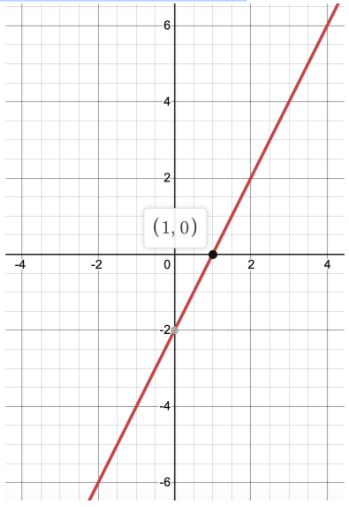
Solution: We are looking for the value when the graph of the function y = 2x - 2 intercepts the x-axis. Graphically, we see that this occurs when x = 1. Thus, the x-intercept in this example is (1, 0).
Algebraically speaking, the x-intercept is just all values of x for which the value of the y-coordinate is zero. This means that we can find the x-intercept of any function without even needing to graph it! 😃
0️⃣ Example 0b: y = 2x - 2
Find the x-intercept of the function y = 2x - 2 algebraically.
Solution: The x-intercept of y = 2x - 2 is the value(s) of x for which the value of y is zero. This means we can substitute zero for y in the equation of the function and get 0 = 2x - 2. All that’s left to do from here is to solve for x: adding 2 to both sides of the equation, we get that 2x = 2 and x = 1. Again, we find that the x-intercept of y = 2x - 2 is (1, 0)! 👑
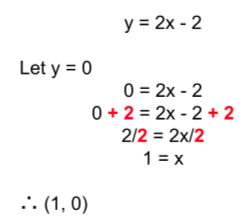
Note that there are two possible ways to find the x-intercept of any function, which offers an excellent way to check your work. Generally, you should always solve for the x-intercept algebraically, as doing so is much more accurate than finding the x-intercept graphically. 📝
Let’s take a look at a few more examples:
1️⃣ Example 1: y = 3x - 5
Find the x-intercept of the function y = 3x - 5 algebraically and graphically.
Solution: To solve for the x-intercept of y = 3x - 5 algebraically, first substitute y with zero. We get 0 = 3x - 5. Adding 5 to both sides of the equation, we get that 3x = 5 and x = 5/3. Our x-intercept is then (5/3, 0). 👏
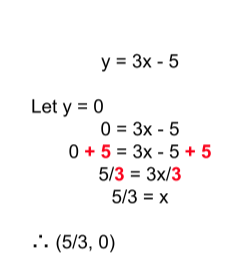
To solve for the x-intercept graphically, plug in points for x to find its corresponding y-values and plot/connect these points. We graph the following: 📈
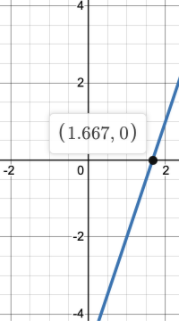
The point at which the graph intersects the x-axis is approximately (1.667, 0), which is an estimation of (5/3, 0). This example in particular shows us that algebraic verification is a must, as graphically finding the x-intercept of most functions isn’t an accurate method.
2️⃣ Example 2: y = x^2 - 4
Find the x-intercept(s) of the function y = x^2 - 4 graphically, and verify your solution algebraically. ✅
Solution: Don’t be intimidated by the exponent—again, first begin by plugging in points and then plotting/connecting them! 🥊
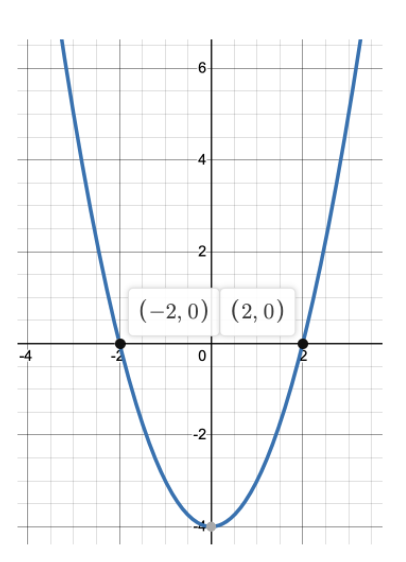
From the graph, we can see that there are x-intercepts at (-2, 0) and (2, 0).
We can verify this algebraically by plugging our x-values into the original equation and verifying that the value of y then becomes zero.
Verify (-2, 0): y = (-2)^2 - 4 = 4 - 4 = 0, so our x-intercept (-2, 0) is valid.
Verify (2, 0): y = (2)^2 - 4 = 4 - 4 = 0, so our x-intercept (-2, 0) is also valid.
3️⃣ Example 3: y = x^2 - 2x +1
Find the x-intercept(s) of the function y = x^2 - 2x + 1 graphically, and verify your solution algebraically.
Solution: We will again first begin with plotting points to sketch a graph. 📊

We see that the function intersects the x-axis at (1, 0). Verifying this algebraically, we get y = (1)^2 - 2(1) + 1 = 1 - 2 + 1 = 0. Thus, our x-intercept (1, 0) is accurate.
Summary: Takeaways & Strategies 🧠
As a quick summary, x-intercepts are the value(s) of x for which the graph intersects the x-axis. They can be found in two ways:
Graphical: Sketch the function by plotting out and connecting points, then approximate the values for which the graph intersects the x-axis. 📉
Algebraic (most accurate!): Set the value of y in the given equation to zero and solve for x. You can (and should!) verify the x-intercepts you derive from a graph this way. 🤓
X-intercepts are also known as zeros or roots and will commonly be referred to by these names in higher mathematics classes. Although the strategy we use to find an x-intercept may seem relatively simple on the surface, this concept is fundamental knowledge for succeeding in advanced math subjects you will encounter later, such as Algebra II and Calculus. 🌳
Finding intercepts also often shows up on many standardized tests, such as on the ACT Math and SAT Math sections, and is even applicable to mathematics within physics (think kinematics). Thus, mastering such a concept is a big step in ensuring your success in these subjects in the future—congratulations! 🎉
How to Find an X-Intercept
4 min read•november 23, 2021
hingryjulia
hingryjulia
Finding X-Intercepts for Function
The x-intercept of a function is the x-value for which the graph intersects the x-axis. We can find x-intercepts either algebraically or graphically. ❌
Let’s look at a basic example:
0️⃣ Example 0a: y = 2x - 2
Find the x-intercept of the function y = 2x - 2 graphically.

Solution: We are looking for the value when the graph of the function y = 2x - 2 intercepts the x-axis. Graphically, we see that this occurs when x = 1. Thus, the x-intercept in this example is (1, 0).
Algebraically speaking, the x-intercept is just all values of x for which the value of the y-coordinate is zero. This means that we can find the x-intercept of any function without even needing to graph it! 😃
0️⃣ Example 0b: y = 2x - 2
Find the x-intercept of the function y = 2x - 2 algebraically.
Solution: The x-intercept of y = 2x - 2 is the value(s) of x for which the value of y is zero. This means we can substitute zero for y in the equation of the function and get 0 = 2x - 2. All that’s left to do from here is to solve for x: adding 2 to both sides of the equation, we get that 2x = 2 and x = 1. Again, we find that the x-intercept of y = 2x - 2 is (1, 0)! 👑

Note that there are two possible ways to find the x-intercept of any function, which offers an excellent way to check your work. Generally, you should always solve for the x-intercept algebraically, as doing so is much more accurate than finding the x-intercept graphically. 📝
Let’s take a look at a few more examples:
1️⃣ Example 1: y = 3x - 5
Find the x-intercept of the function y = 3x - 5 algebraically and graphically.
Solution: To solve for the x-intercept of y = 3x - 5 algebraically, first substitute y with zero. We get 0 = 3x - 5. Adding 5 to both sides of the equation, we get that 3x = 5 and x = 5/3. Our x-intercept is then (5/3, 0). 👏

To solve for the x-intercept graphically, plug in points for x to find its corresponding y-values and plot/connect these points. We graph the following: 📈

The point at which the graph intersects the x-axis is approximately (1.667, 0), which is an estimation of (5/3, 0). This example in particular shows us that algebraic verification is a must, as graphically finding the x-intercept of most functions isn’t an accurate method.
2️⃣ Example 2: y = x^2 - 4
Find the x-intercept(s) of the function y = x^2 - 4 graphically, and verify your solution algebraically. ✅
Solution: Don’t be intimidated by the exponent—again, first begin by plugging in points and then plotting/connecting them! 🥊

From the graph, we can see that there are x-intercepts at (-2, 0) and (2, 0).
We can verify this algebraically by plugging our x-values into the original equation and verifying that the value of y then becomes zero.
Verify (-2, 0): y = (-2)^2 - 4 = 4 - 4 = 0, so our x-intercept (-2, 0) is valid.
Verify (2, 0): y = (2)^2 - 4 = 4 - 4 = 0, so our x-intercept (-2, 0) is also valid.
3️⃣ Example 3: y = x^2 - 2x +1
Find the x-intercept(s) of the function y = x^2 - 2x + 1 graphically, and verify your solution algebraically.
Solution: We will again first begin with plotting points to sketch a graph. 📊

We see that the function intersects the x-axis at (1, 0). Verifying this algebraically, we get y = (1)^2 - 2(1) + 1 = 1 - 2 + 1 = 0. Thus, our x-intercept (1, 0) is accurate.
Summary: Takeaways & Strategies 🧠
As a quick summary, x-intercepts are the value(s) of x for which the graph intersects the x-axis. They can be found in two ways:
Graphical: Sketch the function by plotting out and connecting points, then approximate the values for which the graph intersects the x-axis. 📉
Algebraic (most accurate!): Set the value of y in the given equation to zero and solve for x. You can (and should!) verify the x-intercepts you derive from a graph this way. 🤓
X-intercepts are also known as zeros or roots and will commonly be referred to by these names in higher mathematics classes. Although the strategy we use to find an x-intercept may seem relatively simple on the surface, this concept is fundamental knowledge for succeeding in advanced math subjects you will encounter later, such as Algebra II and Calculus. 🌳
Finding intercepts also often shows up on many standardized tests, such as on the ACT Math and SAT Math sections, and is even applicable to mathematics within physics (think kinematics). Thus, mastering such a concept is a big step in ensuring your success in these subjects in the future—congratulations! 🎉

Resources
© 2024 Fiveable Inc. All rights reserved.
AP® and SAT® are trademarks registered by the College Board, which is not affiliated with, and does not endorse this website.